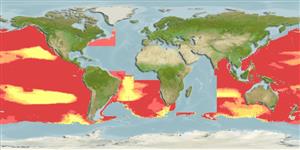Common names from other countries
>
Lophiiformes (Anglerfishes) >
Gigantactinidae (Whipnose anglers)
Etymology: Gigantactis: Greek, 'gigas' or 'gigantos' = gigantic + Greek, 'aktis' = ray (referring to the unusually long first dorsal-fin spine that functions as a lure in this genus) (Ref. 86949).
More on authors: Beebe & Crane.
Environment: milieu / Klimaatzone / Diepte / distribution range
Ecologie
marien bathypelagisch; diepte 670 - 2000 m (Ref. 559). Deep-water
Pacific Ocean: Japan, Indonesia and Hawaii (Ref. 559); Chile (Ref. 9068). Also in the Northwest Atlantic and South Atlantic.
Grootte / Gewicht / Leeftijd
Maturiteit: Lm ? range ? - ? cm
Max length : 22.3 cm SL (female)
Korte beschrijving
Determinatiesleutels | Morfologie | Morfometrie
Dorsale zachte stralen (totaal) : 5 - 7; Anale zachte stralen: 5 - 7. Metamorphosed females distinguished by the following characteristics: have extremely large distal prolongation of escal bulb, entire escal densely covered with slightly elongated papillae; length of illicium less than 120% SL (74-111%SL in specimens greater than 30mm); pair of posterior escal appendages; large dentary teeth (longest 2.2-5.9% SL), arranged in two irregular longitudinal series; rays of caudal fin less than 35% SL (Ref. 86949).
Male unknown.
Levenscyclus en paargedrag
Maturiteit | Voortplanting | Paaien | Eieren | Fecunditeit | Larven
Masuda, H., K. Amaoka, C. Araga, T. Uyeno and T. Yoshino, 1984. The fishes of the Japanese Archipelago. Vol. 1. Tokai University Press, Tokyo, Japan. 437 p. (text). (Ref. 559)
Status op de Rode Lijst van het IUCN (Ref. 130435: Version 2025-1)
Gevaar voor de mens
Harmless
Gebruik door de mens
Visserij: van geen belang
Tools
Speciale rapporten
Download XML
Internetbronnen
Estimates based on models
Preferred temperature (Ref.
123201): 2.7 - 6.1, mean 4.4 °C (based on 901 cells).
Fylogenetische diversiteitsindex (Ref.
82804): PD
50 = 0.5000 [Uniqueness, from 0.5 = low to 2.0 = high].
Bayesian length-weight: a=0.01995 (0.00906 - 0.04395), b=3.01 (2.83 - 3.19), in cm total length, based on all LWR estimates for this body shape (Ref.
93245).
Trofisch niveau (Ref.
69278): 4.1 ±0.7 se; based on size and trophs of closest relatives
Fishing Vulnerability (Ref.
59153): Low vulnerability (17 of 100).
🛈
